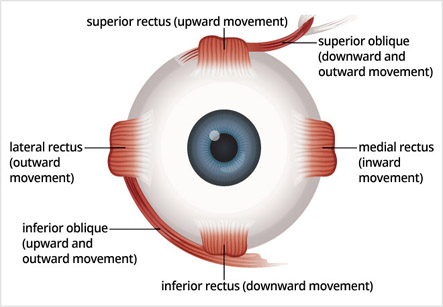Strabismus
Introduction
Strabismus is a disorder in which the two eyes are not lined up in the same direction, and therefore cannot look at the same object at the same time. The condition is more commonly known as crossed eyes or squint.
Causes:
Six different muscles surround the eyes and work in a group so that both the eyes can focus on the same object. In patients of strabismus, these ocular muscles do not work together. As a result, one eye looks at one object, while the other eye is turned in a different direction and is focused on another object.
When this occurs, two different images from each eye are sent to the brain. This confuses the brain, and in time the brain learns to ignore the image from the weaker eye.
If the strabismus is not treated, the eye that the brain ignores will never see well. This loss of vision is called as amblyopia. Sometimes amblyopia is present primarily, and this causes strabismus.
Iran is now ranking first both in the region and in the Middle East and the Iranian ophthalmology science is among the world top majors

The first step in treating strabismus is to prescribe glasses, if needed.
In most children with strabismus, the cause of the disorder is unknown. In more than half of these cases, the problem is present at or shortly after birth (congenital strabismus).
Most of the time, this problem is associated with muscle control, and not the muscle strength.
In a few cases, problems with one of the nerves or muscles or Graves’ disease may cause strabismus.
Other disorders associated with strabismus include:
1. Brain and nerve disorders, such as brain trauma, stroke, cerebral palsy, or Guillain-Barre syndrome.
2. Diabetes which causes a condition known as acquired paralytic strabismus.
3. Damage to the retina in premature children
4. Hemangioma affecting the eye during infancy
5. Injuries to the eye
6. Tumor in the eye
7. Vision loss from any eye disease or injury
8. A family history of strabismus.
9. Farsightedness may be a contributing factor, especially in children.
Symptoms
Symptoms of strabismus may be present all the time, or only when the eyes are tired or the patient is sick. The symptoms include:
1. The eyes do not move together and may appear crossed at times.
2. The other eye appears turned out, up, or down from wherever the first eye is focused.
3. Other symptoms may be loss of depth perception, double vision and vision loss
Diagnosis:
Complete medical history is elicited as well as physical examination is performed including a detailed examination of the eyes. Various tests are also done to determine how much degree of mis-alignment of the eyes is present.
Eye tests include:
1. Corneal light reflex
2. Cover/uncover test
3. Retinal examination
4. Routine eye exam
5. Visual acuity testing
6. A brain and nervous system (neurological) examination is also essential.
Treatment
1. The first step in treating strabismus is to prescribe glasses, if needed.
2. Amblyopia must be treated first. This includes placing a patch over the better eye. This forces the weaker eye to work harder. In children, wearing a patch or eyeglasses may not be feasible. However, it is very important to use the patch or eyeglasses as directed.
3. If there is still problem in eye movements, eye muscle surgery may be needed. Different muscles in the eye can be made stronger or weaker. Eye muscle repair surgery does not fix the poor vision due to amblyopia. A child may have to wear glasses after surgery. In general, the younger a child at the time of surgery, the better the results.
4. Adults with mild strabismus may do well with glasses and eye muscle exercises to keep the eyes straight. More severe forms of adult strabismus will need squint surgery.
5. If strabismus has occurred because of vision loss, the vision loss needs to be corrected before strabismus surgery.
Results:
After surgery, the eyes may look straight but vision problems can be persistent. The child may still have reading problems in school, and adults may find driving more difficult. Vision may affect the ability to play sports.
The problem can usually be corrected with early diagnosis and treatment. However, delay in the treatment may lead to permanent visual loss in one eye. About one-third children with strabismus will develop amblyopia. Also, many children can get strabismus or amblyopia again; they need to be monitored closely.
When to Contact a Medical Professional
Strabismus requires prompt medical evaluation. An appointment with the health care provider or eye doctor is essential if the child:
1. Appears to be cross-eyed
2. Complains of double vision
3. Has difficulty in seeing
4. Learning difficulties or problems at school can sometimes occur due to a child’s inability to see the blackboard or reading material.